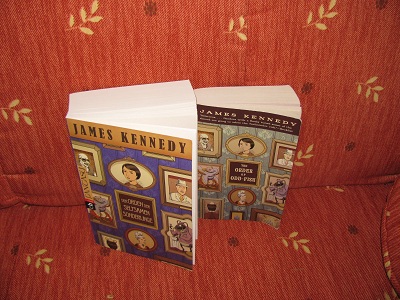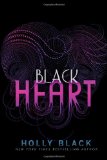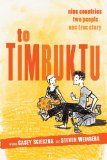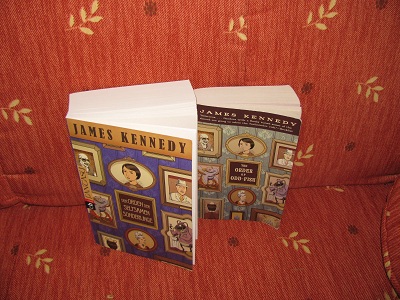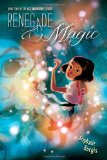Sonderling Sunday – Chapter Four, Part Two
It’s Sonderling Sunday again — loosely translated as Nerd Sonntag. Once again, it’s hitting the end of the day, so I’m not sure how far I’ll get. I’m using the German translation of The Order of Odd-Fish, by James Kennedy, as a bizarre phrase book and having fun making conclusions about language and words.
It’s been a crazy day. I wore my prime factorization sweater to the US Science and Engineering Festival yesterday, and apparently the Math community got the word. As of 11:04 pm, my site has gotten 24907 hits today. Yesterday, it got 156. Can I just say that I think a lot of Math geeks like me will also enjoy looking at these translations? So I decided to do Sonderling Sunday anyway. (Mind you, I also think it’s time to start querying agents about the children’s book I’ve written using the ideas behind the sweater to make codes and patterns and messages with math.)
We’re on page 38 of The Order of Odd-Fish and on Seite 52 of Der Orden der Seltsamen Sonderlinge.
Here are the first two intriguing paragraphs of the next section:
Jo, Aunt Lily, and Korsakov found their way to the kitchen. It still hadn’t been tidied up: crepe paper hung from the ceiling, dirty and damp, and half-filled glasses and stale desserts scattered the tabletops.
Jo opened all the windows to clear the air. She was too shaken to think straight. A package falling from the sky, a talking cockroach, Mr. Cavendish’s head flying around, and now this . . . Aunt Lily stood at the window, looking shell-shocked, and Colonel Korsakov openly wept, overflowing his chair, panting and wheezing.
Here’s how that reads in Der Orden der Seltsamen Sonderlinge:
Jo, Tante Lily und Oberst Korsakov erreichten schlie?lich die Küche. Sie war noch nicht aufgeräumt worden; Krepppapier hing von der Decke, schmutzig und feucht, halb volle Gläser und Schalen mit abgestandenem Dessert stapelten sich auf den Tischen und Ablageflächen.
Jo öffnete alle Fenster, um frische Luft hereinzulassen. Sie war zu erschüttert, um einen klaren Gedanken fassen zu können. Ein Paket, das vom Himmel fiel, eine sprechende Kakerlake, Mr Cavendishs Kopf, der durch die Luft flog, und jetzt das . . . Tante Lily stand am Fenster und wirkte wie vom Donner gerührt, und der Russe weinte ganz ungeniert, während er versuchte, seine Körpermasse auf einen Stuhl zu bugsieren. Er keuchte rasselnd.
Some fun things to notice:
Krepppapier is a real word with three p‘s in a row.
“stale desserts” = abgestandenem Dessert (Basically these desserts have been standing there.)
Hmm. A little discrepancy. In English these stale desserts are just scattered on the tabletops. In German, they’re piled (stapelten) on the tables (Tischen) and shelves (Ablageflächen).
I like that there’s one word for what the air’s supposed to do, and it describes it well. “Jo opened all the windows to clear the air.” becomes Jo öffnete alle Fenster, um frische Luft hereinzulassen. She opened the windows so the fresh air will hereinzulassen, be let in here.
“shell-shocked” = vom Donner gerührt (“from thunder stirred”)
“overflowing his chair” is translated versuchte, seine Körpermasse auf einen Stuhl zu bugsieren, which as far as I can tell means “tried, his body mass on a chair to tow.”
“panting and wheezing” is translated keuchte rasselnd, which Google in turn translates as “gasped rattling.”
Now I’ll go on a little farther and try to limit things to the especially interesting bits and the ones that are fun to say.
Here’s one for the fun-to-say category: “There was a shuffle of footsteps in the hall.” = Im Flur waren schlurfende Schritte zu hören. (“In the corridor were shuffling steps to be heard.”)
“sauntered” = schlenderte
“crop duster” = Düngeflugzeug (“fertilizer flying thing”)
“be neighborly” = mache einen Nachbarschaftsbesuch (make a neighbor-business-visit)
“exterminating” = Insektenvernichtung (“insects destruction”)
“generous piece” = gro?zügiges Stück (“big rapid piece”)
“scoundrel” = Schurke
“knave” = Schluft
“rapscallion” = Halunke
“rogue” = Ganove
This calls for one last paragraph to finish off the section:
“A cur, a reprobate! A blackguard, a villain, a rascal! No, silence! There is nothing more between us, sir, but honor and the sword. As for now — I must find my partner.”
In translation, I think you can pick up which word stands for which:
“Ein Schweinehund, ein Taugenichts! Ein Lump, ein Bösewicht, ein Schlingel! Nein, schweigt! Uns beiden steht nur noch eines offen, Sir, Ehre und Schwert. Jetzt jedoch muss ich zunächst einmal meinen Partner finden.”
There you have it! Lots of ways to insult someone in German. I think my favorite may be the easily understandable Schweinehund (pig-dog).
Perhaps the most practical would be saying, “No, silence!” by shouting Nein schweigt! Don’t you think that will get people quiet?
It’s hard to pick favorites from this section, so I think I’ll go with the “Sch” words: schlurfende Schritte, schlenderte, Schurke, Schluft, Schweinehund, Schlingel, schweigt, Schwert
Tune in next week for more fun! And let me know what happens if you shout, Nein, schweigt!
